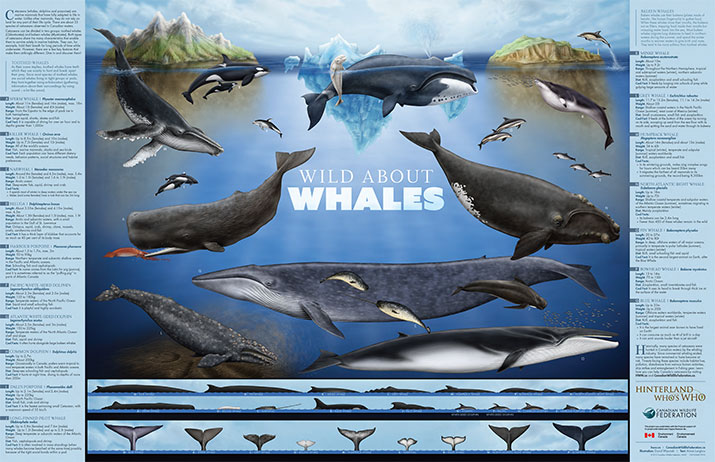 Get your copy of this poster!
Get your copy of this poster!
About this Poster
There are about 33 whale species which visit Canadian waters, but 17 are more common, either as permanent residents or as regular visitors during the summer. With the help of this poster, you’ll get to know them better! Dive in to discover Canada’s whales!
Cetaceans (whales, dolphins, and porpoises) are marine mammals that have fully adapted to life in water. Unlike other mammals, they do not rely on land for any part of their life cycle. There are about 33 species of cetaceans observed in Canadian waters.
Cetaceans can be divided in two groups: toothed whales (Odontocetes) and baleen whales (Mysticetes). Both types of cetaceans share the many characteristics that enable them to survive solely in marine habitats. They can, for example, hold their breath for long periods of time while underwater. However, there are a few key features that make them strikingly different.
Toothed Whales
As their name implies, toothed whales have teeth which they use mainly to hunt and break apart their prey. Since most species of toothed whales are social whales living in tight groups or pods, they hunt together using echolocation (gathering information about their surroundings by using sound – a lot like sonar).
Baleen Whales
Baleen whales use their baleens (plates made of keratin, like human fingernails) to gather food. When these whales close their mouths, the baleens act as filters, trapping food inside their mouths but releasing water back into the sea. Most baleen whales migrate long distances to feed in northern waters during the summer, and spend the winter months in warmer waters to give birth and mate. They tend to be more solitary than toothed whales.
Historically, many species of cetaceans were hunted in Canadian waters by the whaling industry. Since commercial whaling ended, many species have remained or have become at-risk. Threats facing these species include habitat loss, pollution, disturbance from various human activities, ship strikes and entanglement in fishing gear. Learn how you can help Canada’s cetaceans by visiting HWW.ca and CanadianWildlifeFederation.ca.
- Members, order yours today! *While quantitties last
